2007 ISUZU KB P190 BATTERY
[x] Cancel search: BATTERYPage 1283 of 6020
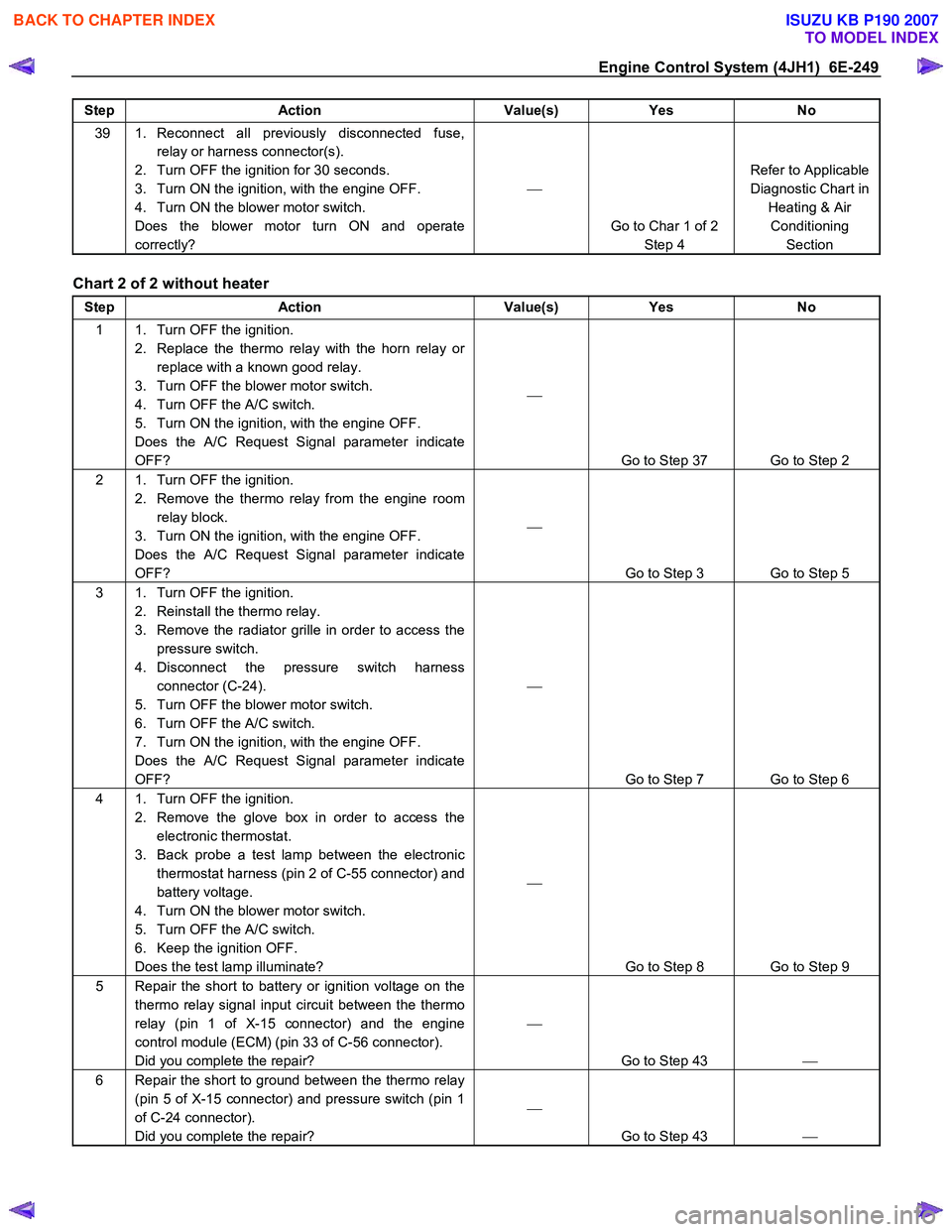
Engine Control System (4JH1) 6E-249
Step Action Value(s) Yes No
39 1. Reconnect all previously disconnected fuse,
relay or harness connector(s).
2. Turn OFF the ignition for 30 seconds.
3. Turn ON the ignition, with the engine OFF.
4. Turn ON the blower motor switch.
Does the blower motor turn ON and operate
correctly?
Go to Char 1 of 2 Step 4 Refer to Applicable
Diagnostic Chart in Heating & Air Conditioning Section
Chart 2 of 2 without heater
Step Action Value(s) Yes No
1 1. Turn OFF the ignition.
2. Replace the thermo relay with the horn relay or replace with a known good relay.
3. Turn OFF the blower motor switch.
4. Turn OFF the A/C switch.
5. Turn ON the ignition, with the engine OFF.
Does the A/C Request Signal parameter indicate
OFF?
Go to Step 37 Go to Step 2
2 1. Turn OFF the ignition. 2. Remove the thermo relay from the engine room relay block.
3. Turn ON the ignition, with the engine OFF.
Does the A/C Request Signal parameter indicate
OFF?
Go to Step 3 Go to Step 5
3 1. Turn OFF the ignition. 2. Reinstall the thermo relay.
3. Remove the radiator grille in order to access the pressure switch.
4. Disconnect the pressure switch harness connector (C-24).
5. Turn OFF the blower motor switch.
6. Turn OFF the A/C switch.
7. Turn ON the ignition, with the engine OFF.
Does the A/C Request Signal parameter indicate
OFF?
Go to Step 7 Go to Step 6
4 1. Turn OFF the ignition. 2. Remove the glove box in order to access the electronic thermostat.
3. Back probe a test lamp between the electronic thermostat harness (pin 2 of C-55 connector) and
battery voltage.
4. Turn ON the blower motor switch.
5. Turn OFF the A/C switch.
6. Keep the ignition OFF.
Does the test lamp illuminate?
Go to Step 8 Go to Step 9
5 Repair the short to battery or ignition voltage on the thermo relay signal input circuit between the thermo
relay (pin 1 of X-15 connector) and the engine
control module (ECM) (pin 33 of C-56 connector).
Did you complete the repair?
Go to Step 43
6 Repair the short to ground between the thermo relay
(pin 5 of X-15 connector) and pressure switch (pin 1
of C-24 connector).
Did you complete the repair?
Go to Step 43
BACK TO CHAPTER INDEX
TO MODEL INDEX
ISUZU KB P190 2007
Page 1285 of 6020

Engine Control System (4JH1) 6E-251
Step Action Value(s) Yes No
16 1. Turn OFF the ignition.
2. Keep the 3-amp fused wire with connected.
3. Disconnect the ECM C-56 harness connector.
4. Connect a test lamp between the thermo relay input circuit (pin 33 of C-56 connector) and a
known good ground.
5. Turn ON the ignition, with the engine OFF. DO NOT START the engine.
Does the test lamp illuminate?
Go to Step 36 Go to Step 24
17 1. Turn OFF the ignition. 2. Keep the 3-amp fused wire with connected.
3. Replace the thermo relay with the horn relay or replace with a known good relay.
4. Connect a 3-amp fused jumper wire between the pressure switch harness (pin 1 of C-24
connector) and a known good ground.
5. Turn ON the ignition, with the engine OFF.
Does the thermo relay click (engage)?
Go to Step 31 Go to Step 25
18 1. Turn OFF the ignition. 2. Connect the pressure switch harness connector.
3. Remove the grove box in order to access electronic thermostat.
4. Disconnect the electronic thermostat harness connector (C-55).
5. Connect a 3-amp fused jumper wire between the electronic thermostat voltage feed circuit (pin 2 of
C-55 connector) and a known good ground.
6. Turn ON the ignition, with the engine OFF.
Does the thermo relay click (engage)?
Go to Step 19 Go to Step 26
19 1. Turn OFF the ignition. 2. Connect a test lamp between the electronic thermostat terminal (pin 1 of C-55 connector) and
battery voltage.
3. Turn ON the blower motor switch.
Does the test lamp illuminate?
Go to Step 20 Go to Step 27
20 1. Turn OFF the ignition. 2. Connect a test lamp between the electronic thermostat voltage feed circuit (pin 3 of C-55
connector) and a known good ground.
3. Turn ON the ignition, with the engine OFF.
Does the test lamp illuminate?
Go to Step 21 Go to Step 28
21 1. Turn OFF the ignition. 2. Connect a test lamp between the electronic thermostat terminal (pin 4 of C-55 connector) and
battery voltage.
3. Turn ON the blower motor switch.
4. Turn ON the A/C switch.
Does the test lamp illuminate?
Go to Step 33 Go to Step 22
BACK TO CHAPTER INDEX
TO MODEL INDEX
ISUZU KB P190 2007
Page 1286 of 6020
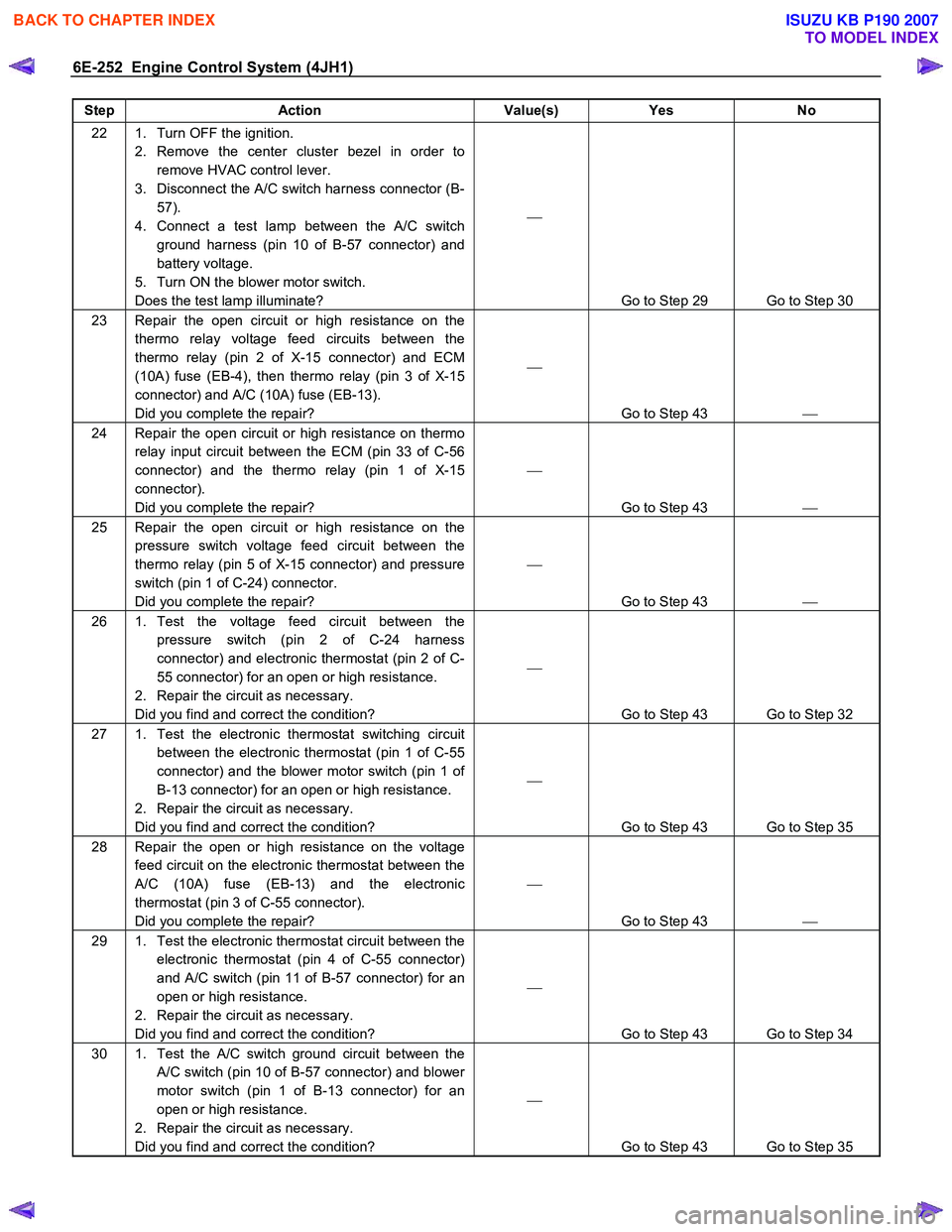
6E-252 Engine Control System (4JH1)
Step Action Value(s) Yes No
22 1. Turn OFF the ignition.
2. Remove the center cluster bezel in order to remove HVAC control lever.
3. Disconnect the A/C switch harness connector (B- 57).
4. Connect a test lamp between the A/C switch ground harness (pin 10 of B-57 connector) and
battery voltage.
5. Turn ON the blower motor switch.
Does the test lamp illuminate?
Go to Step 29 Go to Step 30
23 Repair the open circuit or high resistance on the thermo relay voltage feed circuits between the
thermo relay (pin 2 of X-15 connector) and ECM
(10A) fuse (EB-4), then thermo relay (pin 3 of X-15
connector) and A/C (10A) fuse (EB-13).
Did you complete the repair?
Go to Step 43
24 Repair the open circuit or high resistance on thermo
relay input circuit between the ECM (pin 33 of C-56
connector) and the thermo relay (pin 1 of X-15
connector).
Did you complete the repair?
Go to Step 43
25 Repair the open circuit or high resistance on the
pressure switch voltage feed circuit between the
thermo relay (pin 5 of X-15 connector) and pressure
switch (pin 1 of C-24) connector.
Did you complete the repair?
Go to Step 43
26 1. Test the voltage feed circuit between the
pressure switch (pin 2 of C-24 harness
connector) and electronic thermostat (pin 2 of C-
55 connector) for an open or high resistance.
2. Repair the circuit as necessary.
Did you find and correct the condition?
Go to Step 43 Go to Step 32
27 1. Test the electronic thermostat switching circuit between the electronic thermostat (pin 1 of C-55
connector) and the blower motor switch (pin 1 of
B-13 connector) for an open or high resistance.
2. Repair the circuit as necessary.
Did you find and correct the condition?
Go to Step 43 Go to Step 35
28 Repair the open or high resistance on the voltage feed circuit on the electronic thermostat between the
A/C (10A) fuse (EB-13) and the electronic
thermostat (pin 3 of C-55 connector).
Did you complete the repair?
Go to Step 43
29 1. Test the electronic thermostat circuit between the
electronic thermostat (pin 4 of C-55 connector)
and A/C switch (pin 11 of B-57 connector) for an
open or high resistance.
2. Repair the circuit as necessary.
Did you find and correct the condition?
Go to Step 43 Go to Step 34
30 1. Test the A/C switch ground circuit between the A/C switch (pin 10 of B-57 connector) and blower
motor switch (pin 1 of B-13 connector) for an
open or high resistance.
2. Repair the circuit as necessary.
Did you find and correct the condition?
Go to Step 43 Go to Step 35
BACK TO CHAPTER INDEX
TO MODEL INDEX
ISUZU KB P190 2007
Page 1309 of 6020
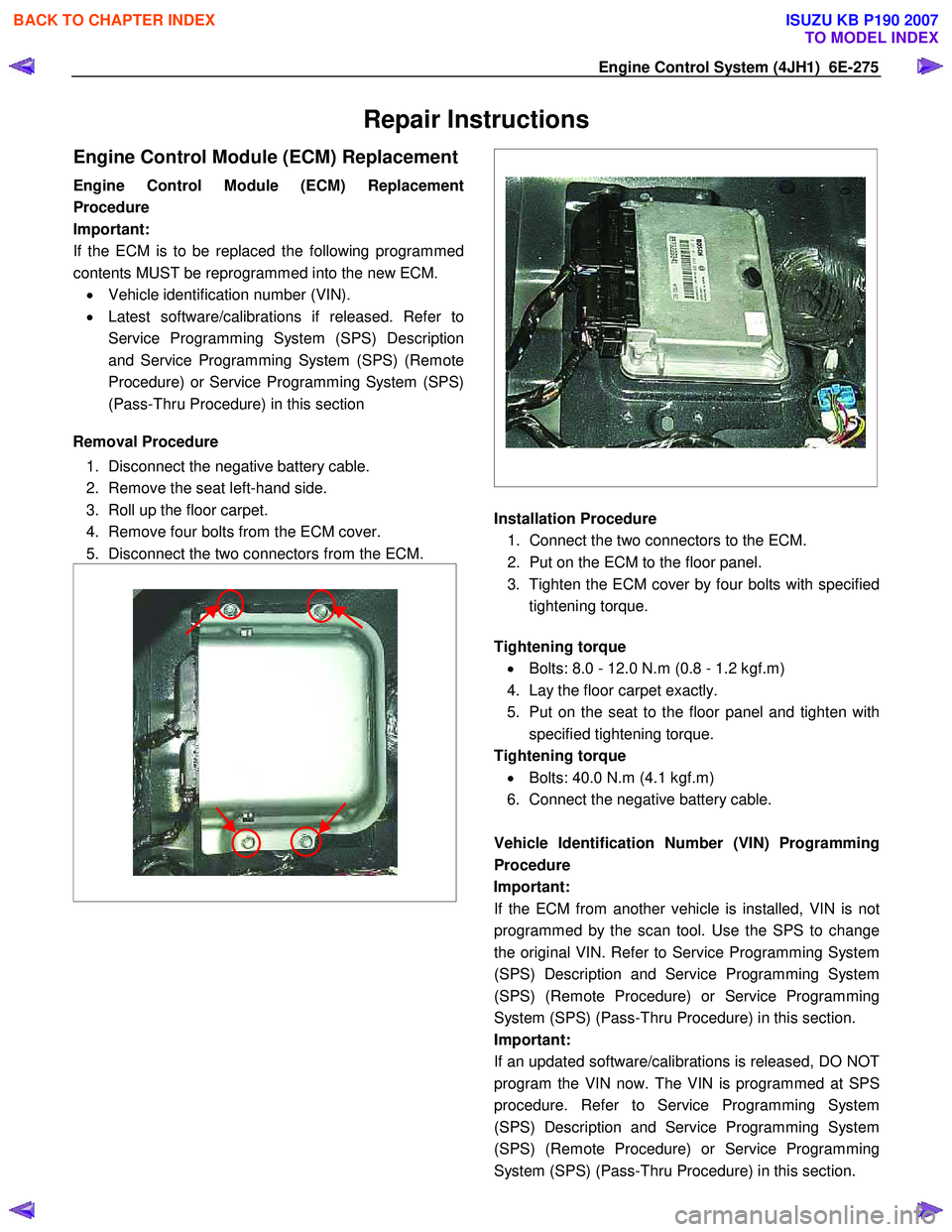
Engine Control System (4JH1) 6E-275
Repair Instructions
Engine Control Module (ECM) Replacement
Engine Control Module (ECM) Replacement
Procedure
Important:
If the ECM is to be replaced the following programmed
contents MUST be reprogrammed into the new ECM. • Vehicle identification number (VIN).
• Latest software/calibrations if released. Refer to
Service Programming System (SPS) Description
and Service Programming System (SPS) (Remote
Procedure) or Service Programming System (SPS)
(Pass-Thru Procedure) in this section
Removal Procedure
1. Disconnect the negative battery cable.
2. Remove the seat left-hand side.
3. Roll up the floor carpet.
4. Remove four bolts from the ECM cover.
5. Disconnect the two connectors from the ECM.
Installation Procedure
1. Connect the two connectors to the ECM.
2. Put on the ECM to the floor panel.
3. Tighten the ECM cover by four bolts with specified tightening torque.
Tightening torque
• Bolts: 8.0 - 12.0 N.m (0.8 - 1.2 kgf.m)
4. Lay the floor carpet exactly.
5. Put on the seat to the floor panel and tighten with specified tightening torque.
Tightening torque • Bolts: 40.0 N.m (4.1 kgf.m)
6. Connect the negative battery cable.
Vehicle Identification Number (VIN) Programming
Procedure
Important: If the ECM from another vehicle is installed, VIN is no
t
programmed by the scan tool. Use the SPS to change
the original VIN. Refer to Service Programming System
(SPS) Description and Service Programming System
(SPS) (Remote Procedure) or Service Programming
System (SPS) (Pass-Thru Procedure) in this section.
Important:
If an updated software/calibrations is released, DO NOT
program the VIN now. The VIN is programmed at SPS
procedure. Refer to Service Programming System
(SPS) Description and Service Programming System
(SPS) (Remote Procedure) or Service Programming
System (SPS) (Pass-Thru Procedure) in this section.
BACK TO CHAPTER INDEX
TO MODEL INDEX
ISUZU KB P190 2007
Page 1310 of 6020
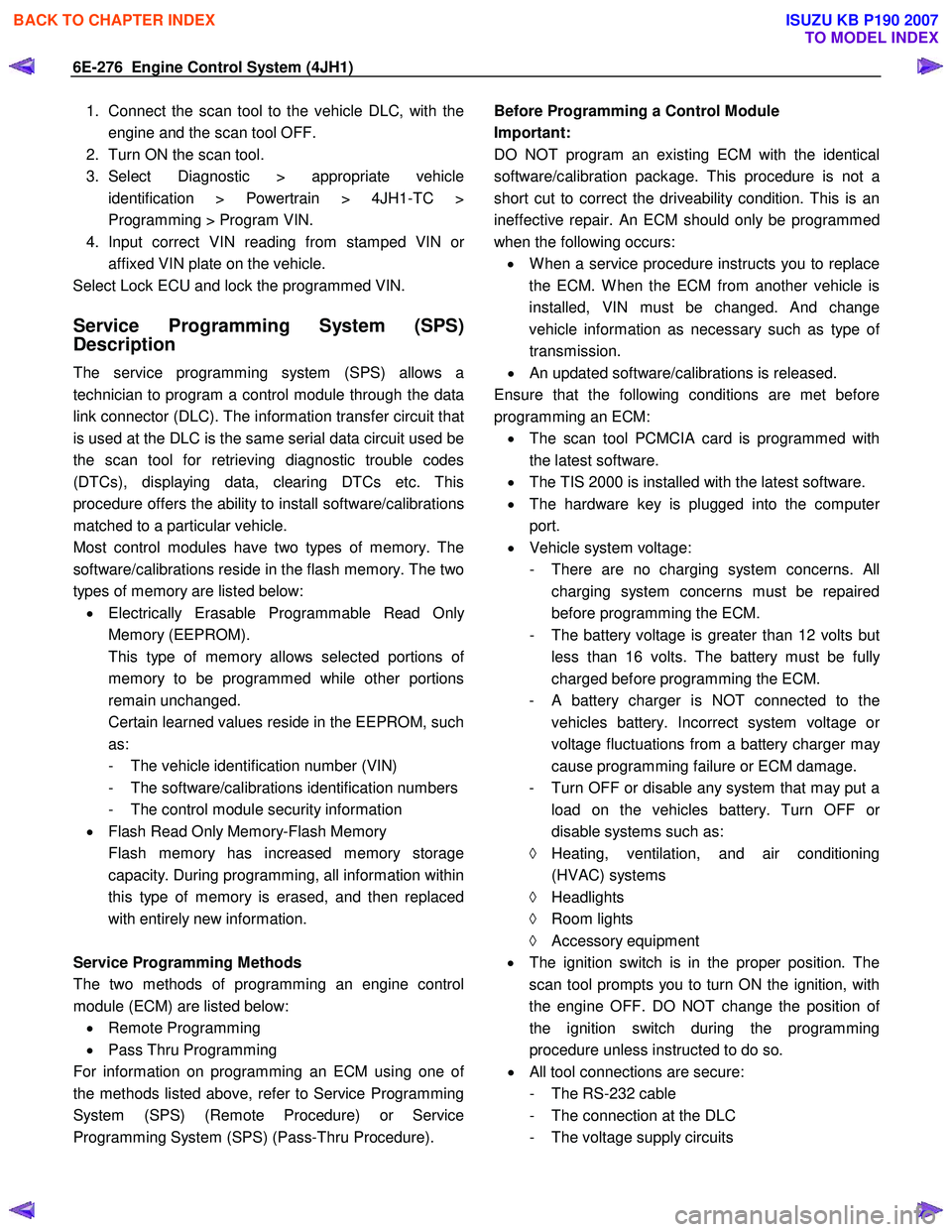
6E-276 Engine Control System (4JH1)
1. Connect the scan tool to the vehicle DLC, with theengine and the scan tool OFF.
2. Turn ON the scan tool.
3. Select Diagnostic > appropriate vehicle identification > Powertrain > 4JH1-TC >
Programming > Program VIN.
4. Input correct VIN reading from stamped VIN o
r
affixed VIN plate on the vehicle.
Select Lock ECU and lock the programmed VIN.
Service Programming System (SPS)
Description
The service programming system (SPS) allows a
technician to program a control module through the data
link connector (DLC). The information transfer circuit that
is used at the DLC is the same serial data circuit used be
the scan tool for retrieving diagnostic trouble codes
(DTCs), displaying data, clearing DTCs etc. This
procedure offers the ability to install software/calibrations
matched to a particular vehicle.
Most control modules have two types of memory. The
software/calibrations reside in the flash memory. The two
types of memory are listed below: • Electrically Erasable Programmable Read Onl
y
Memory (EEPROM).
This type of memory allows selected portions o
f
memory to be programmed while other portions
remain unchanged.
Certain learned values reside in the EEPROM, such as:
- The vehicle identification number (VIN)
- The software/calibrations identification numbers
- The control module security information
• Flash Read Only Memory-Flash Memory
Flash memory has increased memory storage capacity. During programming, all information within
this type of memory is erased, and then replaced
with entirely new information.
Service Programming Methods
The two methods of programming an engine control
module (ECM) are listed below: • Remote Programming
• Pass Thru Programming
For information on programming an ECM using one o
f
the methods listed above, refer to Service Programming
System (SPS) (Remote Procedure) or Service
Programming System (SPS) (Pass-Thru Procedure).
Before Programming a Control Module
Important:
DO NOT program an existing ECM with the identical
software/calibration package. This procedure is not a
short cut to correct the driveability condition. This is an
ineffective repair. An ECM should only be programmed
when the following occurs: • W hen a service procedure instructs you to replace
the ECM. W hen the ECM from another vehicle is
installed, VIN must be changed. And change
vehicle information as necessary such as type o
f
transmission.
• An updated software/calibrations is released.
Ensure that the following conditions are met before
programming an ECM: • The scan tool PCMCIA card is programmed with
the latest software.
• The TIS 2000 is installed with the latest software.
• The hardware key is plugged into the compute
r
port.
• Vehicle system voltage:
- There are no charging system concerns. All charging system concerns must be repaired
before programming the ECM.
- The battery voltage is greater than 12 volts bu
t
less than 16 volts. The battery must be fully
charged before programming the ECM.
-
A battery charger is NOT connected to the
vehicles battery. Incorrect system voltage o
r
voltage fluctuations from a battery charger may
cause programming failure or ECM damage.
- Turn OFF or disable any system that may put a load on the vehicles battery. Turn OFF o
r
disable systems such as:
◊ Heating, ventilation, and air conditioning
(HVAC) systems
◊ Headlights
◊ Room lights
◊ Accessory equipment
• The ignition switch is in the proper position. The
scan tool prompts you to turn ON the ignition, with
the engine OFF. DO NOT change the position o
f
the ignition switch during the programming
procedure unless instructed to do so.
• All tool connections are secure:
- The RS-232 cable
- The connection at the DLC
- The voltage supply circuits
BACK TO CHAPTER INDEX
TO MODEL INDEX
ISUZU KB P190 2007
Page 1311 of 6020
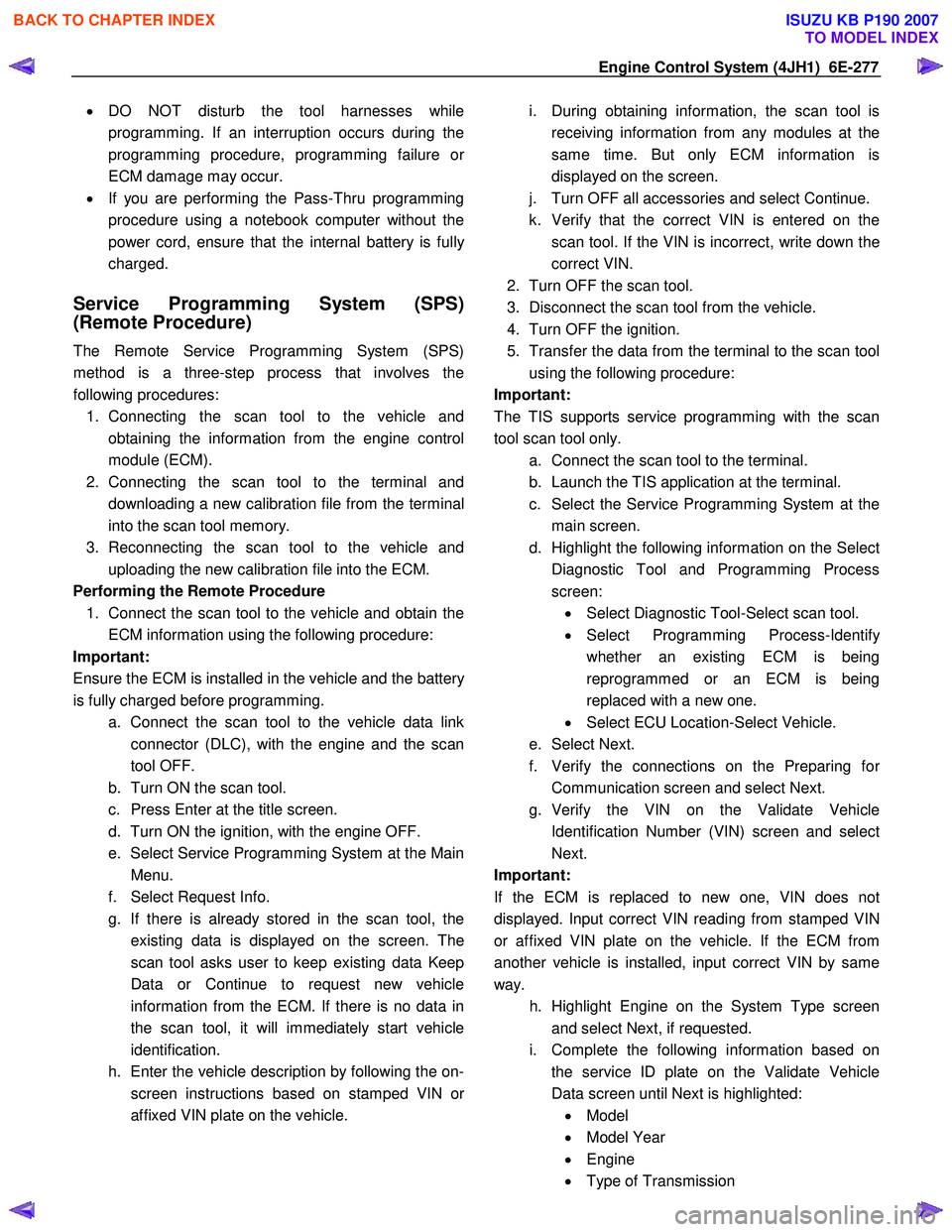
Engine Control System (4JH1) 6E-277
• DO NOT disturb the tool harnesses while
programming. If an interruption occurs during the
programming procedure, programming failure o
r
ECM damage may occur.
• If you are performing the Pass-Thru programming
procedure using a notebook computer without the
power cord, ensure that the internal battery is full
y
charged.
Service Programming System (SPS)
(Remote Procedure)
The Remote Service Programming System (SPS)
method is a three-step process that involves the
following procedures: 1. Connecting the scan tool to the vehicle and obtaining the information from the engine control
module (ECM).
2. Connecting the scan tool to the terminal and downloading a new calibration file from the terminal
into the scan tool memory.
3. Reconnecting the scan tool to the vehicle and uploading the new calibration file into the ECM.
Performing the Remote Procedure 1. Connect the scan tool to the vehicle and obtain the ECM information using the following procedure:
Important:
Ensure the ECM is installed in the vehicle and the batter
y
is fully charged before programming. a. Connect the scan tool to the vehicle data linkconnector (DLC), with the engine and the scan
tool OFF.
b. Turn ON the scan tool.
c. Press Enter at the title screen.
d. Turn ON the ignition, with the engine OFF.
e. Select Service Programming System at the Main Menu.
f. Select Request Info.
g. If there is already stored in the scan tool, the existing data is displayed on the screen. The
scan tool asks user to keep existing data Keep
Data or Continue to request new vehicle
information from the ECM. If there is no data in
the scan tool, it will immediately start vehicle
identification.
h. Enter the vehicle description by following the on- screen instructions based on stamped VIN o
r
affixed VIN plate on the vehicle.
i. During obtaining information, the scan tool is
receiving information from any modules at the
same time. But only ECM information is
displayed on the screen.
j. Turn OFF all accessories and select Continue.
k. Verify that the correct VIN is entered on the scan tool. If the VIN is incorrect, write down the
correct VIN.
2. Turn OFF the scan tool.
3. Disconnect the scan tool from the vehicle.
4. Turn OFF the ignition.
5. Transfer the data from the terminal to the scan tool using the following procedure:
Important:
The TIS supports service programming with the scan
tool scan tool only. a. Connect the scan tool to the terminal.
b. Launch the TIS application at the terminal.
c. Select the Service Programming System at the main screen.
d. Highlight the following information on the Selec
t
Diagnostic Tool and Programming Process
screen: • Select Diagnostic Tool-Select scan tool.
• Select Programming Process-Identif
y
whether an existing ECM is being
reprogrammed or an ECM is being
replaced with a new one.
• Select ECU Location-Select Vehicle.
e. Select Next.
f. Verify the connections on the Preparing fo
r
Communication screen and select Next.
g. Verify the VIN on the Validate Vehicle Identification Number (VIN) screen and selec
t
Next.
Important:
If the ECM is replaced to new one, VIN does no
t
displayed. Input correct VIN reading from stamped VIN
or affixed VIN plate on the vehicle. If the ECM from
another vehicle is installed, input correct VIN by same
way.
h. Highlight Engine on the System Type screen and select Next, if requested.
i. Complete the following information based on the service ID plate on the Validate Vehicle
Data screen until Next is highlighted: • Model
• Model Year
• Engine
• Type of Transmission
BACK TO CHAPTER INDEX
TO MODEL INDEX
ISUZU KB P190 2007
Page 1313 of 6020
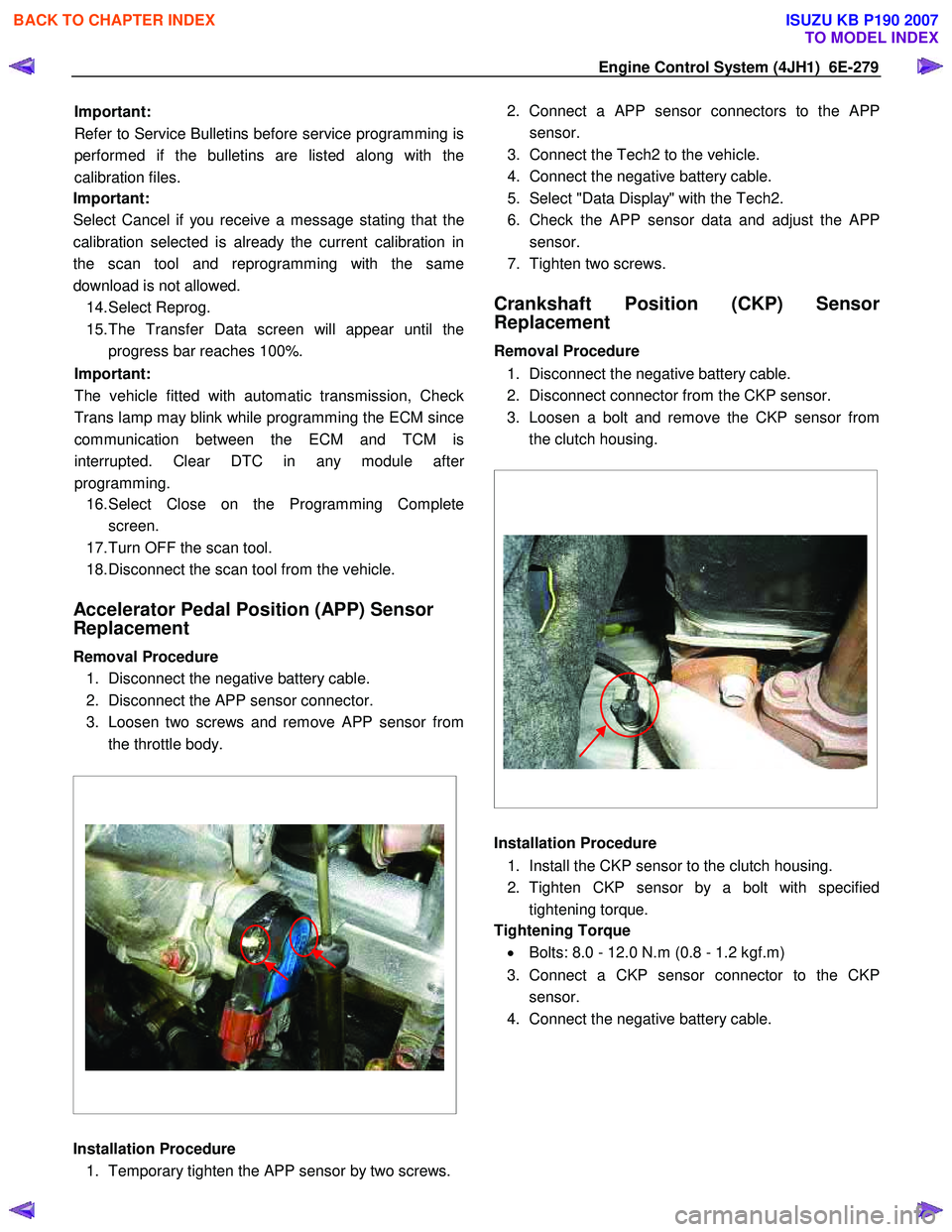
Engine Control System (4JH1) 6E-279
Important:
Refer to Service Bulletins before service programming is
performed if the bulletins are listed along with the
calibration files.
Important:
Select Cancel if you receive a message stating that the
calibration selected is already the current calibration in
the scan tool and reprogramming with the same
download is not allowed.
14. Select Reprog.
15. The Transfer Data screen will appear until the progress bar reaches 100%.
Important:
The vehicle fitted with automatic transmission, Check
Trans lamp may blink while programming the ECM since
communication between the ECM and TCM is
interrupted. Clear DTC in any module afte
r
programming. 16. Select Close on the Programming Complete
screen.
17. Turn OFF the scan tool.
18. Disconnect the scan tool from the vehicle.
Accelerator Pedal Position (APP) Sensor
Replacement
Removal Procedure 1. Disconnect the negative battery cable.
2. Disconnect the APP sensor connector.
3. Loosen two screws and remove APP sensor from the throttle body.
Installation Procedure 1. Temporary tighten the APP sensor by two screws. 2. Connect a APP sensor connectors to the
APP
sensor.
3. Connect the Tech2 to the vehicle.
4. Connect the negative battery cable.
5. Select "Data Display" with the Tech2.
6. Check the APP sensor data and adjust the
APP
sensor.
7. Tighten two screws.
Crankshaft Position (CKP) Sensor
Replacement
Removal Procedure
1. Disconnect the negative battery cable.
2. Disconnect connector from the CKP sensor.
3. Loosen a bolt and remove the CKP sensor from the clutch housing.
Installation Procedure
1. Install the CKP sensor to the clutch housing.
2. Tighten CKP sensor by a bolt with specified tightening torque.
Tightening Torque
• Bolts: 8.0 - 12.0 N.m (0.8 - 1.2 kgf.m)
3. Connect a CKP sensor connector to the CKP sensor.
4. Connect the negative battery cable.
BACK TO CHAPTER INDEX
TO MODEL INDEX
ISUZU KB P190 2007
Page 1314 of 6020
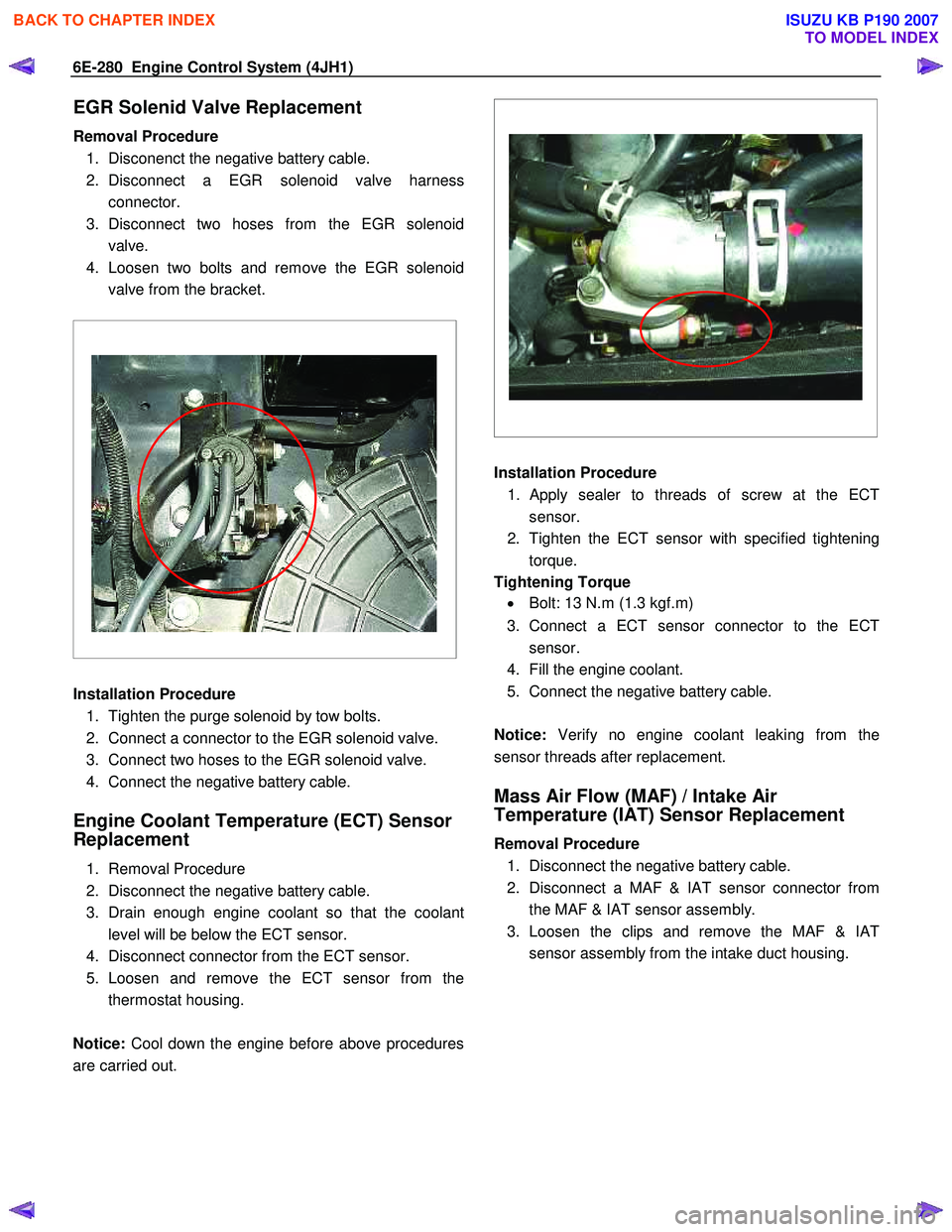
6E-280 Engine Control System (4JH1)
EGR Solenid Valve Replacement
Removal Procedure 1. Disconenct the negative battery cable.
2. Disconnect a EGR solenoid valve harness connector.
3. Disconnect two hoses from the EGR solenoid valve.
4. Loosen two bolts and remove the EGR solenoid valve from the bracket.
Installation Procedure
1. Tighten the purge solenoid by tow bolts.
2. Connect a connector to the EGR solenoid valve.
3. Connect two hoses to the EGR solenoid valve.
4. Connect the negative battery cable.
Engine Coolant Temperature (ECT) Sensor
Replacement
1. Removal Procedure
2. Disconnect the negative battery cable.
3. Drain enough engine coolant so that the coolant level will be below the ECT sensor.
4. Disconnect connector from the ECT sensor.
5. Loosen and remove the ECT sensor from the thermostat housing.
Notice: Cool down the engine before above procedures
are carried out.
Installation Procedure
1.
Apply sealer to threads of screw at the ECT
sensor.
2. Tighten the ECT sensor with specified tightening torque.
Tightening Torque • Bolt: 13 N.m (1.3 kgf.m)
3. Connect a ECT sensor connector to the ECT sensor.
4. Fill the engine coolant.
5. Connect the negative battery cable.
Notice: Verify no engine coolant leaking from the
sensor threads after replacement.
Mass Air Flow (MAF) / Intake Air
Temperature (IAT) Sensor Replacement
Removal Procedure
1. Disconnect the negative battery cable.
2. Disconnect a MAF & IAT sensor connector from the MAF & IAT sensor assembly.
3. Loosen the clips and remove the MAF & IAT sensor assembly from the intake duct housing.
BACK TO CHAPTER INDEX
TO MODEL INDEX
ISUZU KB P190 2007